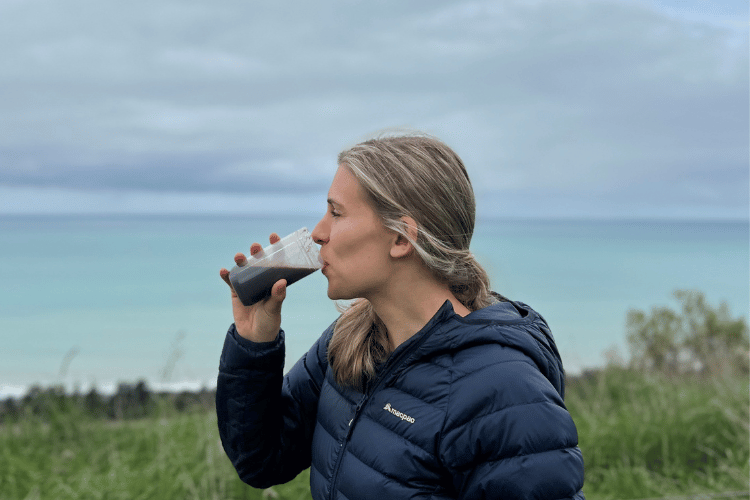If you’re in your late 40’s or early 50’s you’re probably staring down the barrel of “the big M” – menopause, if you’re not already there. It can be a little daunting or scary and it’s something none of us particularly relish experiencing. We don’t tend to talk about it a lot because it might not be something we fully understand, or we might not want to be ‘labelled’, and let’s face it – we might not want the 20-year-old in our office to know we’re about to, or already going through it.
The good news though is it’s not an illness – it’s a natural part of a woman’s life cycle. It does pass.
Menopause is a reality check that your body is changing, so this is a time to take care of yourself by making healthy lifestyle choices. Taking steps to achieve a healthy diet, a good level of fitness and an ideal body weight can help to ease immediate symptoms and improve your longer-term health.
But first let’s clarify…
What’s the difference between perimenopause and menopause?
Perimenopause refers to the period of time right before menopause begins. During perimenopause, your body is beginning the transition into menopause. That means that hormone production from your ovaries is beginning to decline. You may begin to experience some symptoms commonly associated with menopause, like hot flashes. Your menstrual cycle may become irregular, but it won’t cease during the perimenopause stage.
Once you completely stop having a menstrual cycle for 12 consecutive months, you’ve entered menopause.
How does it affect your body?
The reduction in oestrogen levels cause many changes to your body, which can result in physical symptoms.
During perimenopause, the fall in oestrogen levels start to affect your body’s metabolism. You might notice you have a tendency to gain weight, especially around your middle section, even without changing your dietary habits. Other physical changes might start to make themselves known, such as changes in cholesterol levels (which can increase the risk of heart disease), and losing calcium from your bones (raising the risk of osteoporosis). Other symptoms can include hot flashes, night sweats, irritability, poor concentration, more frequent headaches, and joint pains.
Fortunately, not every woman will have every symptom, and some of the lucky few experiences very little symptoms (lucky them!)
If you want to take steps to help your body cope with these life changes, then here are 10 tips to get you started in the right direction.
1. The right portions
From around your mid 30s you start to lose muscle mass, and its muscle mass that burns calories. As you creep past 40 you might find the weight around your waist starts to increase, even if you haven’t changed your dietary habits. During menopause, your muscle mass starts to reduce, which means you need fewer calories. Serve as many wholefoods as possible especially more veggies or salads and lean proteins with smaller portions of starchy foods. Remember, at least half your meal should be made up of fruits and vegetables.
2. Eat regular meals and plan ahead
Eating regular meals helps with weight control and can help reduce some of the mood swings and fatigue that can come with menopause.
If you find you’re the kind of person that does need to snack, then plan ahead and make healthier snacks rather than grabbing the first thing you see.
If you find you often have a 3pm energy slump, then rather than reaching for a sugary drink or snack, try our Red Shot – it’s full of energy-giving, antioxidant-rich berries, and a healthier alternative.
3. Fibre for digestive health
Changes in hormones may increase any tendency towards sluggish digestion, bloating and constipation. The best way to tackle this is to eat higher fibre foods and drink plenty of liquids. Fibre also helps us to feel fuller for longer.
Plants including vegetables, fruit, wholegrains and legumes contain lots of fibre, and some studies suggest a high-fibre diet may be associated with a lower risk of depression for women during perimenopause.
Whole grain foods include brown rice, whole wheat bread, barley, quinoa, and rye. Look for “whole grain” listed as the first ingredient on the label when evaluating which packaged foods contain primarily whole grains avoiding ultra-processed foods.
In a one-year intervention study in over 17,000 menopausal women, those eating more vegetables, fruit, fibre and soy experienced a 19% reduction in hot flashes compared to the control group. The reduction was attributed to the healthier diet and weight loss.
Did you know all our whole food powders are made by simply removing the water from the plant and then powdering them, which means they contain all the natural fibre of the whole plant? Wheatgrass in particular is very high in fibre. This awesome ingredient can be found in our Double Shot and Green Shot.
4. Calcium and Vitamin D for bone density
From the age of 35 we slowly lose calcium from our bones. Losing oestrogen during menopause speeds this loss up dramatically, which can increase the risk of osteoporosis. Boosting your intake of both calcium and Vitamin D is important to help reduce this risk.
There are lots of nutrients that keep bones healthy, so it’s important to have a healthy diet. Dairy products, such as milk, yogurt and cheese, contain calcium, phosphorus, potassium, magnesium and Vitamins D and K. While dairy is a good source of calcium, there are many fruits and vegetables that are also rich in calcium. Barley leaf is rich in Vitamin K, green peas are rich in calcium, magnesium and phosphorus, and boysenberries contain high levels of Vitamin K1.
Vitamin D is also important for bone and muscle health. Even if you have a calcium-rich diet, without enough Vitamin D your body can’t absorb the calcium into your bones and cells where it’s needed. Your skin makes it in response to sunlight. Because of the risks of sunburn and skin cancer, we need to be careful how much sun we get. Here is a guide to sensible sun exposure to get your Vitamin D.
Strength-building physical activities are also beneficial in rebuilding lost muscle mass which helps to slow down the mineral loss in your bones.
5. Omega-3s
Omega-3s are the type of fat found in oily types of fish (e.g. salmon, sardines, mackerel, herring, trout, and vegetarian sources like flax seed and chia seeds). Eating these weekly can help to keep your heart healthy. Omega-3s have also been found to help improve mood. Research has shown that omega-3s can decrease the frequency of hot flushes and the intensity of night sweats.
6. Plant oestrogens
Plant oestrogens (also called phytoestrogens) are similar to human oestrogen. If eaten regularly and in sufficient quantities, they can start to have mild oestrogen-like effects, which may help to balance your hormones.
For some women this can be enough to relieve menopause symptoms, but it’s worth noting that:
- It can take 2 to 3 months for the benefits to be seen
- They seem to work better for some women than others which could be down to differences in gut bacteria
- Eating plant oestrogens several times a day seems to be more effective than one larger does
Foods that contain phytoestrogens are broccoli, cauliflower, dark berries, chickpeas, peanuts, flax seeds, barley, grapes, plums, green and black tea, soybeans, and many more.
Interestingly, the high intake of phytoestrogens in Asian countries such as Japan is thought to be the reason why menopausal people in these places rarely experience hot flushes.
7. Quality protein
Because there is a decline in muscle mass and bone strength during menopause, it’s a good idea to eat more lean protein. Guidelines recommend that women over 50 eat 20 to 25 grams of high-quality protein per meal.
In a large study in adults over 50, eating dairy protein was linked to an 8% lower risk of hip fracture, while eating plant protein was linked to a 12% reduction.
Foods high in protein include eggs, meat, fish, legumes and dairy products. Green peas are also high in protein, which is one of the ingredients in our Double Shot and Green Shot.
We would recommend you eat organic or free-range meat whenever possible in order to keep unwanted toxins to a minimum with maximum nutrient content.
8. Fruits and vegetables
Fruits and vegetables are packed with vitamins and minerals, fibre and antioxidants. It’s why current guidelines recommend filling at least half your plate with fruits and vegetables.
A diet rich in fruits and veg can help prevent a number of menopause symptoms. They may also help prevent a number of diseases, including heart disease. This is important, since heart disease risk tends to increase after menopause. This could be due to factors such as age, weight gain, or possibly reduced levels of oestrogen.
Fruits and veg also help to prevent bone loss. One observational study of 3,236 women ages 50 to 59 found that diets high in fruit and vegetables may lead to less bone breakdown.
Cruciferous veggies may be especially helpful. In one study, eating broccoli decreased levels of a type of oestrogen linked to breast cancer, while increasing levels of an oestrogen type that protects against breast cancer.
Dark berries, like boysenberries and blackcurrants, are also helpful for lowering blood pressure and mood swings because of their high levels of anthocyanins. Dark berries are also full of antioxidants which help to rid our bodies of free radicals, which in turn helps with ageing. We might be having hot flushes, but there’s nothing wrong with having glorious hair, skin and nails while we’re going through menopause! Blackcurrants and boysenberries can be found in our Double Shot and Red Shot.
9. Be physically active
Adults should do at least 30 minutes a day of moderate intensity physical activity most days of the week. Being active doesn’t have to mean a trip to the gym. You can be doing daily activities such as taking the stairs, parking further from your destination, gardening or dancing. Pick activities you enjoy and get moving with friends and family.
Aim for strength-building activity at least twice a week. Not only will this help build back lost muscle mass, but it also helps slow down mineral loss in your bones.
10. Drink plenty of water
Water keeps you hydrated and may help manage hot flushes. It also helps dietary fibre move through the body, which is especially important if you’re increasing your intake of fruits and veg. Drinking water can help reduce the bloating that can occur with hormonal changes.
Foods to avoid:
- Sugary and highly processed foods can cause sharp rises and dips in blood sugar, making you feel tired and irritable which could worsen the physical and mental symptoms of menopause. High blood sugar and insulin resistance have been linked to a higher incidence of hot flushes in menopausal women
- Limit your intake of alcohol and caffeine, which studies have shown can trigger hot flashes (Reference 1 and 2)
- High salt food has been linked to lower bone density in postmenopausal women. After menopause the decline in oestrogen increases your risk of developing high blood pressure. Reducing your sodium intake may help lower this risk.
Menopause is a natural part of a woman’s life. Following menopause, your risk for certain conditions like osteoporosis or cardiovascular disease may increase, so take care of yourself by taking the necessary steps to living a healthier, more active life.
Remember to be kind to yourself. You’re not alone. Talk to your friends and family and don’t be afraid to ask for their support.
You should contact your doctor if you experience adverse symptoms that affect your ability to function, or if you notice anything unusual that might require a closer look. There are plenty of treatment options to help with symptoms like hot flushes.
Check in with your doctor during regular gynaecological exams as you experience menopause.















